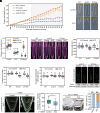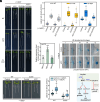Ethylene-independent modulation of root development by ACC via downregulation of WOX5 and group I CLE peptide expression
- PMID: 39908106
- PMCID: PMC11831204
- DOI: 10.1073/pnas.2417735122
Ethylene-independent modulation of root development by ACC via downregulation of WOX5 and group I CLE peptide expression
Abstract
In seed plants, the canonical role of 1-aminocyclopropane-1-carboxylic acid (ACC) is to serve as the precursor in the biosynthesis of the phytohormone ethylene, and indeed, ACC treatment is often used as a proxy for ethylene treatment. Increasing evidence suggests that ACC can also act independently of ethylene to regulate various aspects of plant growth and development. Here, we explore the effects of ACC on Arabidopsis thaliana root growth and the mechanisms by which it acts. ACC inhibits growth of the primary root in Arabidopsis seedlings when ethylene signaling is blocked, which becomes evident after 36 h of treatment with ACC. This reduced root growth is in part the result of suppressed cell proliferation in the root meristem resulting from altered expression of a key regulator of stem cell niche activity, WOX5. ACC also promotes lateral root (LR) development, in contrast to ethylene, which inhibits LR formation. Transcriptomic analysis of roots revealed no significant changes in gene expression after 45 min or 4 h of ACC treatment, but longer treatment times revealed a large number of differentially expressed genes, including the downregulation of the expression of a small group of phylogenetically related CLE peptides. Reduced expression of these group 1 CLEs in response to ACC leads to the activation of a transcription factor, LBD18, which promotes LR development. These results suggest that ACC acts to modulate multiple aspects of Arabidopsis root growth independently of ethylene via distinct transcriptional effects in the root meristem and LR precursor cells.
Keywords: ACC; CLE peptides; ethylene; lateral roots; root development.
Conflict of interest statement
Competing interests statement:The authors declare no competing interest.
Figures




Similar articles
-
RGIs-mediated root apical meristem development is essential for root hydrotropic response in Arabidopsis thaliana.Plant J. 2025 Jun;122(6):e70273. doi: 10.1111/tpj.70273. Plant J. 2025. PMID: 40561222
-
A CLE14 Signalling Cascade Promotes Arabidopsis Root Hair Elongation.Plant Cell Environ. 2025 Aug;48(8):6251-6268. doi: 10.1111/pce.15584. Epub 2025 May 7. Plant Cell Environ. 2025. PMID: 40341593
-
Arabidopsis WRKY71 regulates ethylene-mediated leaf senescence by directly activating EIN2, ORE1 and ACS2 genes.Plant J. 2021 Sep;107(6):1819-1836. doi: 10.1111/tpj.15433. Epub 2021 Aug 10. Plant J. 2021. PMID: 34296474
-
To grow or not to grow: the enigma of plant root growth dynamism.Plant Mol Biol. 2025 Jul 30;115(4):93. doi: 10.1007/s11103-025-01631-4. Plant Mol Biol. 2025. PMID: 40736880 Review.
-
Systemic pharmacological treatments for chronic plaque psoriasis: a network meta-analysis.Cochrane Database Syst Rev. 2021 Apr 19;4(4):CD011535. doi: 10.1002/14651858.CD011535.pub4. Cochrane Database Syst Rev. 2021. Update in: Cochrane Database Syst Rev. 2022 May 23;5:CD011535. doi: 10.1002/14651858.CD011535.pub5. PMID: 33871055 Free PMC article. Updated.
Cited by
-
EBSn, a robust synthetic reporter for monitoring ethylene responses in plants.bioRxiv [Preprint]. 2025 May 28:2025.05.23.655144. doi: 10.1101/2025.05.23.655144. bioRxiv. 2025. PMID: 40501970 Free PMC article. Preprint.
-
Out of the Niche: A Bird's-Eye View of the Molecular Networks Controlling Root Stem Cells.Plants (Basel). 2025 Aug 19;14(16):2574. doi: 10.3390/plants14162574. Plants (Basel). 2025. PMID: 40872197 Free PMC article. Review.
-
Small signaling peptides define leaf longevity.Front Plant Sci. 2025 Jun 20;16:1616650. doi: 10.3389/fpls.2025.1616650. eCollection 2025. Front Plant Sci. 2025. PMID: 40621048 Free PMC article. No abstract available.
-
Quantitative analysis of ethylene precursor ACC in plant samples by liquid chromatography-tandem mass spectrometry.BMC Plant Biol. 2025 Jul 17;25(1):920. doi: 10.1186/s12870-025-06943-7. BMC Plant Biol. 2025. PMID: 40676506 Free PMC article.
References
-
- Yang S. F., Hoffman N. E., Ethylene biosynthesis and its regulation in higher plants. Annu. Rev. Plant Physiol. 35, 155–189 (1984).
MeSH terms
Substances
Grants and funding
LinkOut - more resources
Full Text Sources

